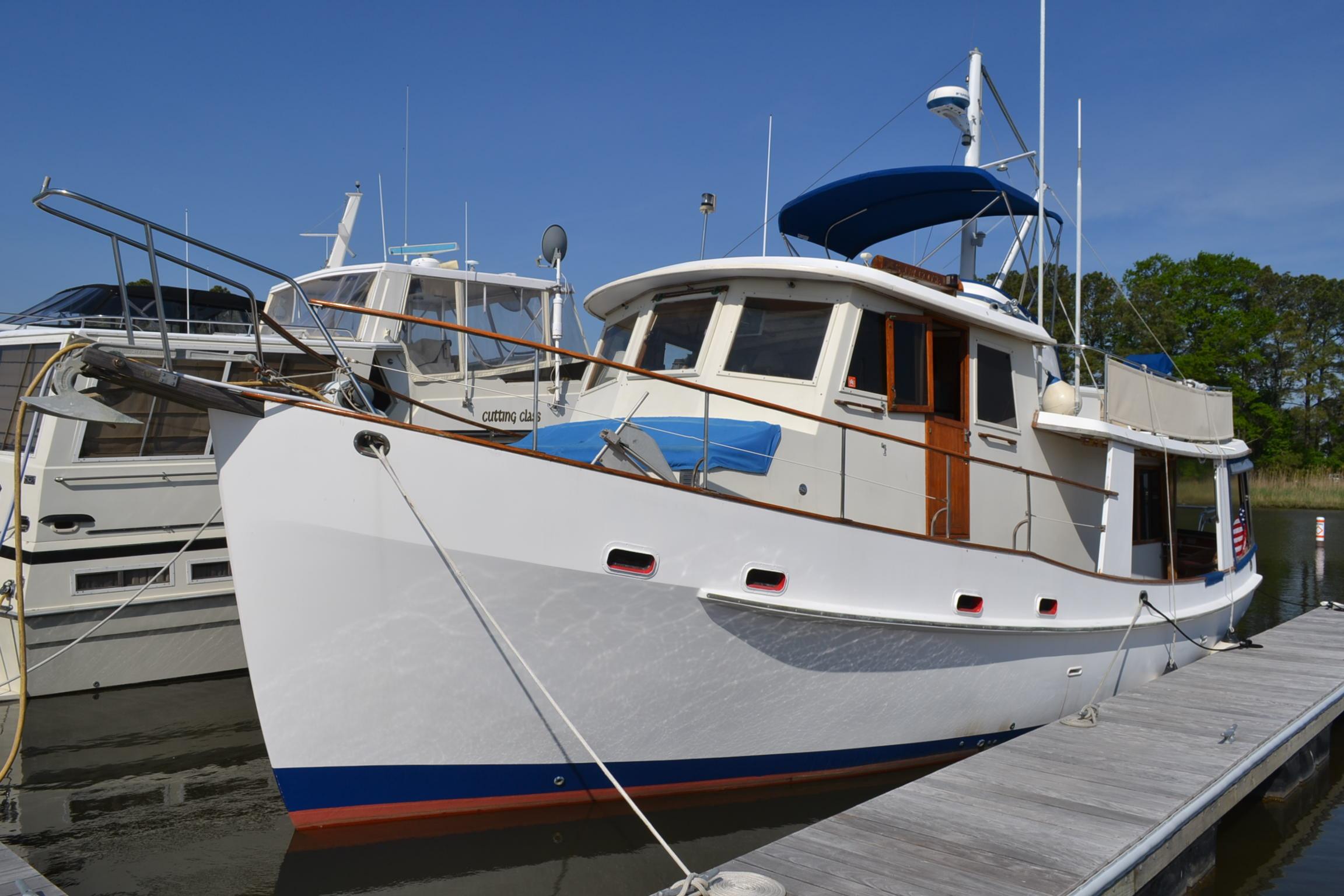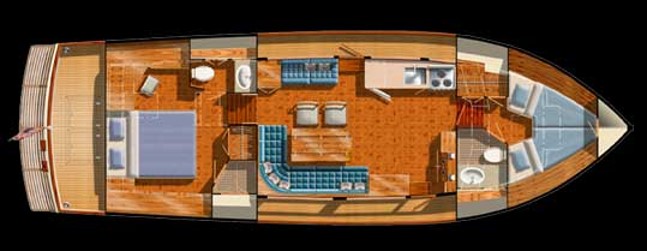In the first post of this discussion about identifying and selecting a good cruising powerboat, http://bit.ly/whats_a_trawler, I hoped to convey that a trawler in the traditional sense has morphed or evolved into many different kinds of cruising boats. In the second post on this subject, we looked at various hull shapes and identifieds the pros ands cons of the available choices, http://bit.ly/The_Right_Boat.
Now we take the bull by the horns and get real about the serious questions you must honestly answer to determine the parameters that you use to narrow the focus of the boats you are looking for. It is not difficult, but too many people make it harder than it needs to be, and/or create a wish list that frankly has nothing to do with how they really plan to use the boat when they go cruising.
Key Questions
There is much more to consider besides hull shape when looking for your boat, and it relates to some questions that help define the boat in general terms. But it requires honest evaluation of one’s answers to these questions. If you can do that you'll be a step ahead in developing specifications that map out the right boat.
The first question is how many people will be aboard? If you are simply a couple, with only occasional guests, your accommodations needs will be quite different from those of a family with several children, or couples regularly traveling with family and friends, each needing a separate stateroom.
Depending on where you come out on this question, the solution may be as simple as a boat with a single, comfortable stateroom, rather than the floating hotel many feel necessary because of the potential possibilities. (In fact, many couples initially think they will be cruising with guests, but find they rarely have any other people onboard, as they make friends with their own boats, and ultimately decide they don’t need the expense and upkeep of a large boat.)
The next question is apparently a difficult one for many would-be passagemakers, because I have had many conversations to help scale this down to reality: Where do you really intend to go cruising? Exploring the Bahamas and the U.S. East Coast is a hugely different deal than an extended Caribbean exploration of Central and South America. The Great Loop fits a boat that has very different specs than a boat well suited for bluewater travel.
Too many people confuse the dream with what is a realistic assessment of their plans. It might be nice to know your boat can go to Tahiti, but if you never ever get out of sight of land, perhaps that boat would not be the best choice for coastal and inland cruising, and might be prohibitively expensive for capabilities you will never need.
The third question is how long do you plan to be away? If you envision seasonal vacation cruises, or a one-year Great Loop, you’ll be looking for a different cruising capability than a couple planning full-time retirement and living aboard for years into the future, as snow birds, wanderers, and island hoppers from one marina to the next. This is an important question because you can compromise for short term adventure in ways that would be impossible if you plan this to be your full time home. Watch any of those tiny home TV shows and see if that convertible dinette table that transforms into a bed would drive you mad if you had to go through this every night for the next several years.
What is your real budget? The answer to that question is important if you want to move away from fantasy boat shopping and get real. Far too many people put off going cruising because they've talked themselves into "needing" a boat that is super capable, perhaps way more than they need, and which they simply can't afford. There are so many boats out there to fit almost any budget, so one can always find a suitable boat and go cruising now, rather than put it off indefinitely. As obvious as this seems, it is a real stumbling block for many couples. Yes, the interior of that 45-footer is beautiful and would be great, but perhaps the smaller 38-foot sistership would work as well and fit your budget.
The answers to these four questions will help define some basic boundaries, hopefully bringing you closer to knowing what you are looking for in a boat. This may even be enough perspective to go to a boat show and really see what is available.
So with that in mind, let’s look closer at some other details that may be helpful.
If you have guests or family aboard, this layout provides separation and privacy between cabins. Nice to have if you need it.
All finish and appointment issues aside, the basic layout of one boat with work better for some than others. The traditional separation of cabins, for example, where the aft cabin puts owners at the opposite end of the boat than those in a forward stateroom in the bow—this works to maintain some level of privacy. But for a couple who rarely have guests, it means going up and down step to move around the boat. As a result, many find the “Europa” style layout, where the accommodations are on one level, works well when it is just the two of you. Guest staterooms are right next to owner cabins, and privacy is only an illusion on this type boat. But if guests are not aboard, such a layout is superb, and the guest cabin can be turned into the ship’s office, complete with computer, printer, and file storage.
This layout works best for a couple who can use the guest stateroom accommodations for other uses. There is zero privacy with this layout, as the stateroom doors are often louvered for ventilation.
(Living on a boat is very different once you shove off, and some layout details that may not be obvious at the dock can drive you nuts once your cruise begins. For that reason, chartering a similar style boat is often an excellent way to see how it works for you, if it does.)
Yet another layout shows accommodations forward and down from the main saloon level. Again, it seems this would work best for only occasional guests and the owners are able to utilize the guest cabin as an office or sewing room.
Another key issue for many people is deciding what kind of style you embrace. Do you wait for perfect weather or do you go no matter what? Will you anchor out most of the time or stay at a marina? Do you tend to move around or stay in one place during a cruise? (As I wrote in an earlier blog, are you a mover or as stayer?: http://bit.ly/Whats_your_style) Knowing your style will help refine your comfort levels, and dictate what kind of boat might work best. Subtle design elements will support one style more than another, so it helps to know your style before discussing a particular boat with a dealer.
Details, Details
Along with layout choices, another area that is almost more crucial for happy cruising than the boat itself is a careful review of the boat’s systems and their accessibility. Other considerations include making sure there are sufficient hand holds inside and out, usable by all members of the crew. Are there sturdy side deck lifelines or hand rails? Look for steps instead of ladders, which are more dog/child friendly and ease the burden of carrying groceries, dive gear, and provisions aboard. Are there boarding gates and doors that handle varying dock and tidal situations? You must have the ability to get on or off the boat without outside assistance, or you looking at the wrong boat.
In terms of convenience, how can you store, launch and retrieve the dinghy? Is there storage for deck gear, fenders and lines? Does the boat offer dedicated dining space or will you be forced into saloon seating with plates balanced on knees? Does the helm station have proper visibility; is there room for necessary electronics, and seating for crew near the helm while under way? Are there sufficient opening ports for ventilation in different conditions? Are there adequate attachment points for fenders along the side decks? (Sounds like a silly question, I know, but you will be surprised how often there are not.)
Does the boat have a sturdy rubrail? If not, keep looking, as it is not a serious cruising boat.
Is the engine room space accessible, with enough physical space for you to do routine checks and maintenance without taking the boat apart? Are pumps, batteries, relays, and switches accessible? The same goes for main engine, generator, and the fuel system.
One Last Thing
The last important point to hold close to you heart is to acknowledge that this is, after all, a boat. And sometimes, you’ll have to redefine the dream that led you to this particular craft. Ageing parents, a changing portfolio and world economy, and family or medical issues all impact the initial plan. And it is okay to redefine the dream when this happens.
And it is perfectly okay to change the boat if it no longer fits what your plan is as it changes. I see this all the time, and the most successful cruisers somehow maintain a balance of all of life’s elements, while enjoying the pleasure of boating.
But the most important thing I offer is that you can go cruising on any boat. Just think it through, find a boat that fits your needs (and perhaps no more), and go cruising. The worse thing you can do is rob yourself of the joys of cruising while dreaming an adventure never to happen, on a boat that remains out of reach.
Good luck! The search can be a lot of fun...














